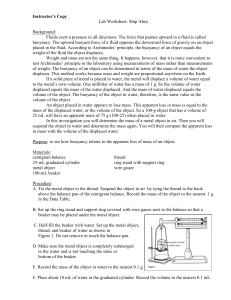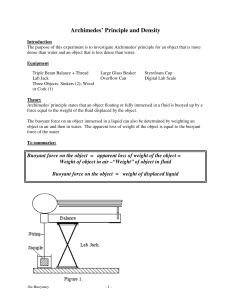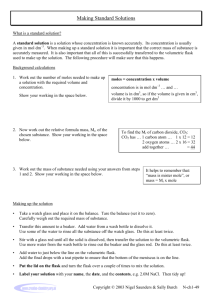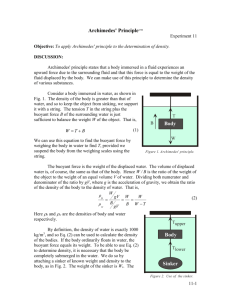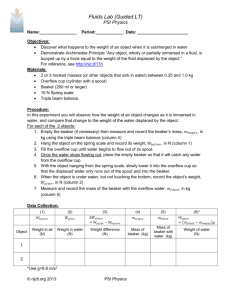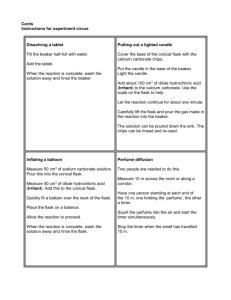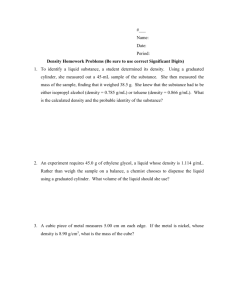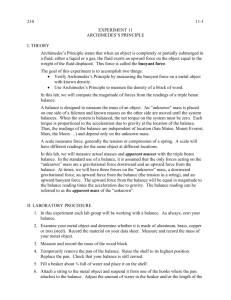Archimedes' Principle & Buoyancy Lab: Density Experiments
advertisement
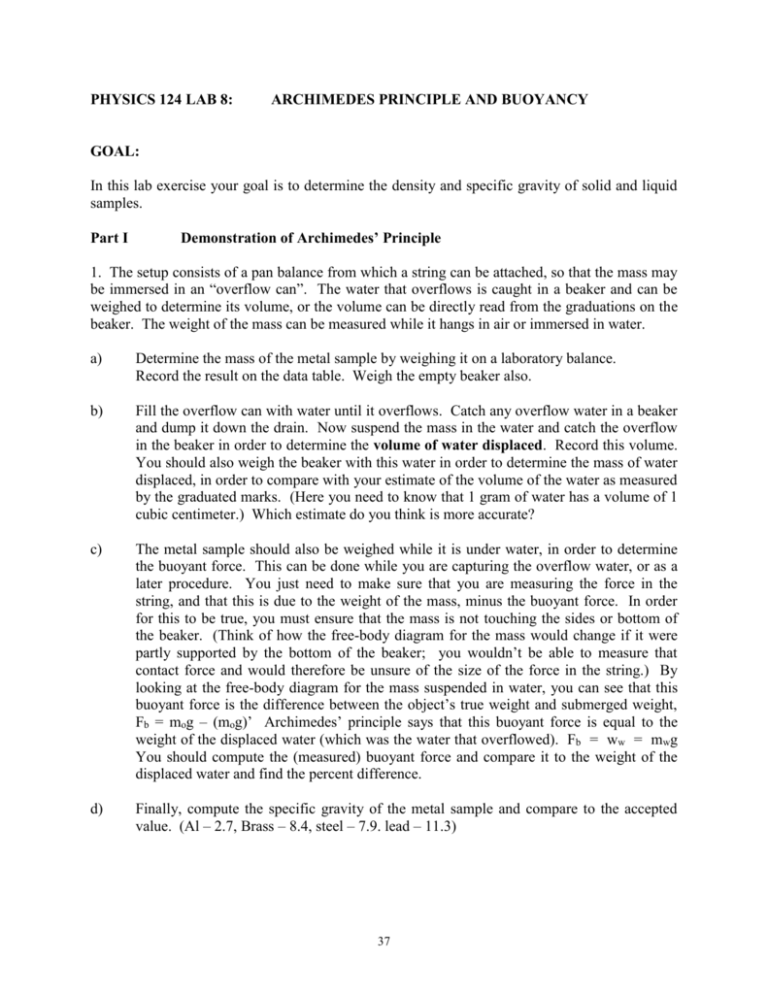
PHYSICS 124 LAB 8: ARCHIMEDES PRINCIPLE AND BUOYANCY GOAL: In this lab exercise your goal is to determine the density and specific gravity of solid and liquid samples. Part I Demonstration of Archimedes’ Principle 1. The setup consists of a pan balance from which a string can be attached, so that the mass may be immersed in an “overflow can”. The water that overflows is caught in a beaker and can be weighed to determine its volume, or the volume can be directly read from the graduations on the beaker. The weight of the mass can be measured while it hangs in air or immersed in water. a) Determine the mass of the metal sample by weighing it on a laboratory balance. Record the result on the data table. Weigh the empty beaker also. b) Fill the overflow can with water until it overflows. Catch any overflow water in a beaker and dump it down the drain. Now suspend the mass in the water and catch the overflow in the beaker in order to determine the volume of water displaced. Record this volume. You should also weigh the beaker with this water in order to determine the mass of water displaced, in order to compare with your estimate of the volume of the water as measured by the graduated marks. (Here you need to know that 1 gram of water has a volume of 1 cubic centimeter.) Which estimate do you think is more accurate? c) The metal sample should also be weighed while it is under water, in order to determine the buoyant force. This can be done while you are capturing the overflow water, or as a later procedure. You just need to make sure that you are measuring the force in the string, and that this is due to the weight of the mass, minus the buoyant force. In order for this to be true, you must ensure that the mass is not touching the sides or bottom of the beaker. (Think of how the free-body diagram for the mass would change if it were partly supported by the bottom of the beaker; you wouldn’t be able to measure that contact force and would therefore be unsure of the size of the force in the string.) By looking at the free-body diagram for the mass suspended in water, you can see that this buoyant force is the difference between the object’s true weight and submerged weight, Fb = mog – (mog)’ Archimedes’ principle says that this buoyant force is equal to the weight of the displaced water (which was the water that overflowed). Fb = ww = mwg You should compute the (measured) buoyant force and compare it to the weight of the displaced water and find the percent difference. d) Finally, compute the specific gravity of the metal sample and compare to the accepted value. (Al – 2.7, Brass – 8.4, steel – 7.9. lead – 11.3) 37 Part II e) Density of a light object Determine the density of a wooden block by using a heavy metal object as a sinker. There are several ways to do this, and your instructor will show one before lab. First, though, weigh the wooden block while it is still dry. One way is to hang the sinker below the wooden block so that 1 or 2 cm of string separates the two, then immerse the sinker but leave the wooden block above the surface. Record the apparent mass of the two objects, as measured by the balance. Then raise the container of water so that both the sinker and block are immersed, and record the apparent mass of the two. The difference between these two measurements is that the block is immersed or not, and so the difference in the apparent masses is related to the buoyant force created when you immerse the wooden block. Therefore, you can just take the difference in apparent masses, write it in grams, and immediately conclude that this is the mass of the water displaced (by Archimedes’ principle). Therefore, the volume of water displaced is equal to this number (of cubic centimeters) and you don’t even need to measure the actual water displaced. Now that you know the volume of water displaced by the block, you deduce that it is also the volume of the block. Then, knowing the mass and volume of the block, you calculate the density of the wooden block by using the recorded dry mass of the block and its deduced volume, and applying the definition of density = m/V. Part III f) Density of a liquid The density of a liquid will be determined directly by using a container with an accurate volume of liquid and simply weighing the volumetric flask with and without the liquid to determine the mass of the liquid. Therefore the calculation of density is immediate. This will be done with a “mystery” liquid which will be available in the laboratory. This liquid is harmless unless you drink a moderate amount of it. Start by weighing the empty flask (with its glass plug). Fill the flask to slightly overflowing with the unknown liquid, and then put the plug in (gently, don’t push too hard or it might get jammed). Wipe off excess liquid and weigh the full flask. Please recycle the liquid to the Erlenmeyer flask (conical flask) after weighing the full volumetric flask. You can read the volume of the flask off the side and directly calculate the density of the fluid from the mass of liquid and its exact volume. Compare your calculated density to the known density of some possible fluids. 38 Physics 124 Data and results for Lab 8 Name _____________________________ a) Density of heavy solid Type of metal ______________ Mass of metal mo in air ___________________ Mass of beaker mb ____________ b) Mass of beaker and displaced water (mb + mw) _________________ Mass of displaced water ___________ Volume of displaced water (cm3) ____________ (How does this relate to the mass of water?) c) Apparent mass of metal mo’ when suspended in water ________________ Difference between true mass and apparent mass under water (mo – mo’) ______________ Buoyant force (in Newtons) Fb = mog – (mog)’ = (mo – mo’)g = ___________________ Weight of displaced water (in Newtons) _______________________ Percent difference of these two forces ____________ d) Density of metal sample _________________ Specific gravity of metal sample ________ Show calculations here: 39 e) Density of light solid (wood) Mass of dry wooden block in air _________________ Mass of block and sinker with only sinker submerged __________________ Mass of block and sinker with both submerged __________________ Difference in measured apparent masses ______________________ Deduced volume of displaced water (hence volume of block) _________________ Density of wooden block ______________________ f) Density of liquid Mass of empty volumetric flask _____________________ Mass of full flask ______________________ Mass of liquid (difference of above masses) ___________________ Density (divide by 50 mL volume of flask) __________________ Question: The accepted value of specific gravity for pure isopropanol is 0.786. For rubbing alcohol it is 0.79. For methanol it is 0.81. For water it is 1.00. Which liquid do you think it is? Is your value a little high? If so, what contamination might there be in the liquid? 40

